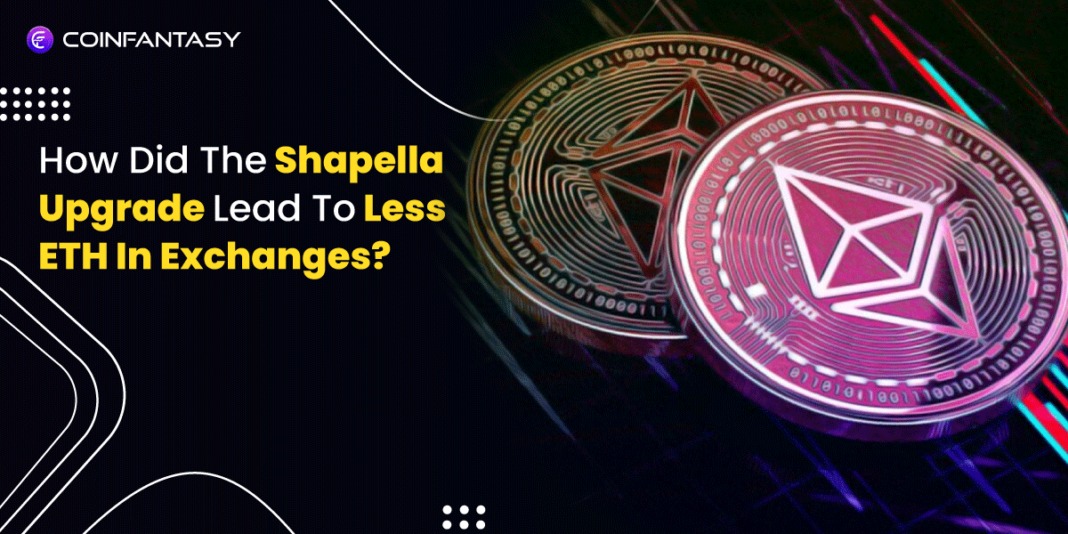The Shapella update went well, allowing millions of staked ETH to be retrieved. Although the Ethereum Merge in September seemed to be more of a “buy the gossip, sell the story” sort of event, Shapella looks to have had the reverse effect on price and resulted in less ETH in Exchanges.
The Shapella upgrade is referred to as Ethereum Shanghai and Capella upgrade. It was the last stage in Ethereum’s shift from a proof-of-work to a proof-of-stake. One of the most significant benefits of the update is that traders who had previously been unable to get back their staking frozen Ethereum are able to do so now due to this transition.
After the Beacon Chain became online in December 2020 (before the Ethereum 2.0 Combine), around 15% of the overall circulated Ethereum supply has been staked. Individuals were able to stake 32 ETH to become blockchain validators, but they were unable to get their staked ETH until today. The high amount of tokens engaged in it, so it raised concerns about the Shanghai upgrade.
PoS will also enhance the Ethereum blockchain’s economic performance, since under PoW, Ethereum distributed 5.4 million ETH to miners each year, but will only release roughly 500,000 ETH as a reward to stakers. This may slow growth and cause ether to become decreasing in price, as a percentage of fees for transactions will be burnt, lowering the coin’s total supply.
However, despite this upgrade, the availability of Ether across crypto exchanges has hit a five-year low. As of May 26 2023, only 17.86 million ETH were held in exchanges, a drastic fall in the altcoin supply since 2018.
Although a proportion of this decline is due to FTX collapse, the major reason could be the Shapella upgrade. While the upgrade was directed to withdrawing staked ETH, the majority of stakers didn’t come forward to do it.
What Has Changed Since the Ethereum Shapella Upgrade?
Some analysts were afraid that the Shanghai upgrade would be detrimental to Ethereum. Their biggest worry was that validators would finally be allowed to take out all of their staked ETH, which could result in many people selling and dropping their ETH holdings who had previously been unable to use them.
Whereas barely a week after the Ethereum Shapella update, Ethereum consumers have begun to stake more ETH than withdraw. This has resulted in less ETH in exchanges.
The change is significant since staked Ether accounts for around one-seventh of the overall quantity of approximately 16 million tokens. The present worth of all Ether staked is more than $26 billion. Addressing concerns about raised selling pressure after the start of withdrawals on April 12. At the moment, more than half of the ETH invested (9.7 million out of 17.9 million) is losing money.
Despite forecasts of considerable sale demand when more than 1 million staked ETH were removed, ETH achieved 11-month peaks after the Shapella upgrade. BTC has also surpassed $30k for the first time as of last June and has increased more than 80% year to date. Against predictions of huge selling, ETH spot prices fell by over 18% post-Merge and have gained 11% since Shapella.
The Shapella upgrade should have no additional consequences for ETH holders. It is not anticipated to have an impact on blockchain-based coins or smart contracts. Decentralized apps (dApps) should continue to operate normally.
Because the launch of shards, which divide a blockchain into smaller portions, is expected this year, the Shapella enhancement shouldn’t dramatically boost Ethereum’s scalability either.
When sharding is finished, the speed of ETH will be increased to 100,000 transactions per second, up from the present level of only 25. It will also reduce transaction costs, making payments more affordable.
How Ether’s Value Hit $2000?
Even though many people withdrew part of their cash, and sources indicate that millions of dollars in ETH transfers were handled in moments of the upgrade, there was no anxiety or bad emotion in the market. This demonstrated investors’ ongoing faith in Ethereum. As an outcome, the cost of ETH increased by 6% to $2,000. It achieved a further record of $2,100 two days afterward, the most since June 2022.
Drop-In Transaction Fees Post the Shapella Upgrade
While a lot of attention has been concentrated on withdrawing a stake in Ethereum, the Shapella update primarily aims to lower gas costs for users. As a consequence, both developers and consumers now pay lower transaction prices even during peak hours, as compared to previously. Because these decreased prices applicable to Ethereum and other Layer-2 applications on the Ethereum blockchain, they should decrease transaction fees for regular consumers.
Furthermore, the upgrade has reduced transaction costs associated with the payment of the maximum obtainable value while utilizing COINBASE, an application that allows developers to get their new tokens (rather than the increasingly popular cryptocurrency exchange), which was formerly costly. These modifications will make it simpler for the network on Ethereum to cope with increased use.
Closing Thoughts
From the above phrases we have noted that there are not much more changes in the Ethereum network after the Shapella upgrade. Most people started to withdraw stake in ETH and some people started to stake to become a validator. That’s why it leads to less ETH in exchanges.

